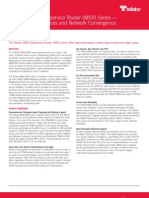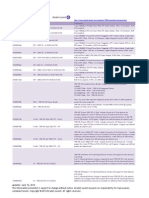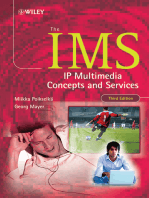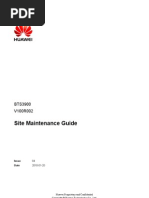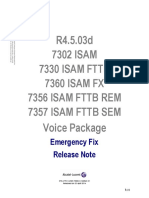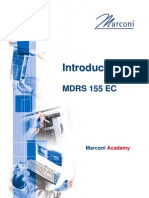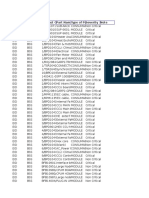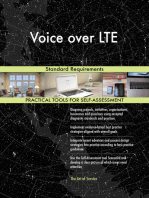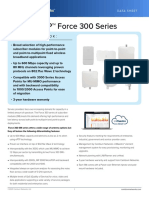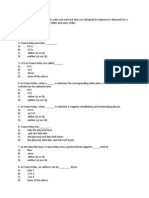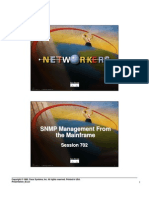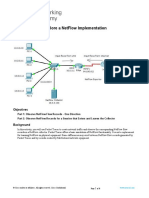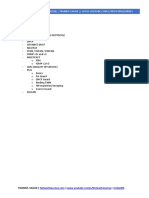Reference Ipa2800
Uploaded by
arun29mhzReference Ipa2800
Uploaded by
arun29mhz3G Platform
Basics of the Nokia IPA2800 Platform
Training Document
CTXX 5906 Issue 1.0 en
Nokia Networks Oy
1 (42)
Basics of the Nokia IPA2800 Platform
The information in this document is subject to change without notice and describes only the product defined in the introduction of this documentation. This document is intended for the use of Nokia Networks' customers only for the purposes of the agreement under which the document is submitted, and no part of it may be reproduced or transmitted in any form or means without the prior written permission of Nokia Networks. The document has been prepared to be used by professional and properly trained personnel, and the customer assumes full responsibility when using it. Nokia Networks welcomes customer comments as part of the process of continuous development and improvement of the documentation. The information or statements given in this document concerning the suitability, capacity, or performance of the mentioned hardware or software products cannot be considered binding but shall be defined in the agreement made between Nokia Networks and the customer. However, Nokia Networks has made all reasonable efforts to ensure that the instructions contained in the document are adequate and free of material errors and omissions. Nokia Networks will, if necessary, explain issues which may not be covered by the document. Nokia Networks' liability for any errors in the document is limited to the documentary correction of errors. Nokia Networks WILL NOT BE RESPONSIBLE IN ANY EVENT FOR ERRORS IN THIS DOCUMENT OR FOR ANY DAMAGES, INCIDENTAL OR CONSEQUENTIAL (INCLUDING MONETARY LOSSES), that might arise from the use of this document or the information in it. This document and the product it describes are considered protected by copyright according to the applicable laws. NOKIA logo is a registered trademark of Nokia Corporation. Other product names mentioned in this document may be trademarks of their respective companies, and they are mentioned for identification purposes only. Copyright Nokia Networks Oy 2001. All rights reserved.
2 (42)
Nokia Networks Oy
CTXX 5906 Issue 1.0 en
Contents
Contents
1 2 2.1 2.2 3 3.1 3.2 3.2.1 3.2.2 4 4.1.1 4.2 5 5.1 5.2 5.3 5.3.1 5.3.2 5.4 6 6.1 7 8 8.1 8.2 8.3 9 Objectives ............................................................................................. 4 Introduction .......................................................................................... 5 IPA2800 Packet Platform functionality.................................................... 6 Aspects of the Nokia IPA2800 platform .................................................. 7 Basic architecture of Nokia IPA2800................................................... 8 Redundancy in the Nokia IPA2800 platform ........................................... 9 Capacity of the Nokia IPA2800 platform ............................................... 10 Interface and switching capacity........................................................... 10 Processing capacity ............................................................................. 11 IPA2800 platform hardware ............................................................... 12 ESD protection ..................................................................................... 15 IPA2800 hardware management system.............................................. 16 IPA2800 processing platform ............................................................ 17 Computing platform .............................................................................. 17 Switching platform ................................................................................ 19 Signal processing platform ................................................................... 21 Speech transcoding.............................................................................. 22 Macro-Diversity Combining .................................................................. 23 Example of user traffic through the RNC to MGW ................................ 23 Transmission management in the IPA2800 ...................................... 28 Basic implementation of ATM in the IPA2800....................................... 29 Synchronisation and timing in the IPA2800 platform ...................... 31 Operating and maintaining the IPA2800 ........................................... 33 IPA2800 maintenance system .............................................................. 33 IPA2800 user interfaces ....................................................................... 34 Network Element Management Unit (NEMU) ....................................... 36 Review of IPA2800 basics.................................................................. 38 Glossary of platform terminology ..................................................... 41
CTXX 5906 Issue 1.0 en
Nokia Networks Oy
3 (42)
Basics of the Nokia IPA2800 Platform
Objectives
The aim of this module is to give the participant the conceptual knowledge needed for explaining the basics of the Nokia IPA2800 platform. Topics to be covered in this module include a look at the general architecture and the hardware used. As the IPA2800 is used in 3G networks, the module looks at the different types of processing platforms that are utilised. A short look of transmission and synchronisation is included for completeness. Finally, the module examines the role of operation and maintenance in the IPA2800. After completing this module, the participant should be able to:
Identify and list the key aspects of the Nokia IPA2800 platform in terms of its computing platform, motivation for development, and its application in the mobile network. Using a block diagram, list and identify the key functional units. Also, list and briefly explain each of the three redundancy principles that can be found in the IPA2800. Furthermore, explain how platform's capacity can be increased. List and explain the different hardware mechanics found in the IPA2800 cabinet. Also, identify the relationship between the subrack and plug-in unit. Furthermore, list the precautions that should be taken when handling the plug-in units. Using an illustrated figure, identify what are the three domains of the processing platform. Identify the differences between each domain in terms of its functions. Also, clarify what is the signal-processing domain and give an example of its use. Using a very brief model, explain the different types of ATM protocols used in the transmission of the IPA2800 and how it is visualised. Briefly explain how synchronisation and timing is achieved in the IPA2800 RNC and MGW units. List the four basic functions of the operating and maintenance system. Also, clarify the use of the web-based (NEMU) and text-based (MML) interfaces. Make reference to practical uses of each.
All of the objectives can be met through the use of this material and access to NOLS.
4 (42)
Nokia Networks Oy
CTXX 5906 Issue 1.0 en
Introduction
Introduction
The IPA2800 Packet Platform Principles have been developed to meet the needs of the evolution in mobile networks. As networks move from being circuit switched to packet switched, the requirements on the physical platform change. The physical platform must be fault tolerant, scaleable, low cost to maintain, and reliable. However, unlike the GSM circuit switched world, the 3G mobile network requires increased computer and signal processing power assuring QoS (Quality of Service).
Figure 1.
The Nokia RNC (IPA2800 platform)
The hardware mechanism for the IPA2800 platform is designed to use the minimal amount of footprint space (that is, physical space) as possible. In the Nokia 3G Solution, the IPA2800 platform is used in the Nokia Radio Network Controller (RNC) and the MGW (MSC Media Gateway).
CTXX 5906 Issue 1.0 en
Nokia Networks Oy
5 (42)
Basics of the Nokia IPA2800 Platform
2.1
IPA2800 Packet Platform functionality
The IPA2800 Packet Platform consists of the switching platform, fault tolerant computing platform, signal processing platform, and the hardware platform. In addition, adjunct platforms can be used if needed in an application.
Applications
Application Software Signal Fault Tolerant Switching Processing Computing Platform Platform Platform Software SW SW Modular and Scaleable Hardware
Core System Platform
Adjunct Platform (NEMU)
Figure 2.
IPA2800 functional architecture
The switching platform provides common telecom functions (for example, statistics, routing, and address analysis) as well as generic packet switching/routing functionality common for several application areas (for example, connection control, traffic management, ATM network operations and maintenance, and resource management). The fault tolerant computing platform provides a distributed and fault tolerant computing environment for the upper platform levels and the applications. It is ideal for use in implementing flexible, efficient, and fault tolerant computing systems. The computing platform is based upon general-purpose computer units with inter-processor communications implemented using ATM virtual connections. The number of computer units can be scaled according to application and network element specific processing capacity requirements. The hardware platform based on standard mechanics provides cost efficiency through the use of modular optimised and standardised solutions that are largely based on commercially available chipsets. The signal-processing platform provides generic services for all signalprocessing applications. Digital signal processing (DSP) is needed in providing computation intensive end-user services, such as speech transcoding, echo cancellation, or macro-diversity combining. The adjunct platform (NEMU) provides a generic platform for O&M application services and different NE management applications and tools.
6 (42)
Nokia Networks Oy
CTXX 5906 Issue 1.0 en
Introduction
2.2
Aspects of the Nokia IPA2800 platform
Designing a platform product requires flexibility in order to be able to develop applications for different network environments based on the platform. Some of the requirements are common system requirements to most of the applications in service provider networks (see the left hand side box above) or requirements stemming from operation efficiency or reuse of legacy functionality. However, various potential application areas bring their specific requirements to platform development (see the right hand side box above). The QoS in the ATM networks depends above all on the reliability of the systems; in the core network the full redundancy of the system is a clear requirement. Furthermore, a sophisticated maintenance system to guarantee automatically and autonomously the availability of the network element is needed. The platform must be scalable to fulfil the requirements of different applications. However, the configurations for particular products can be optimised to guarantee the cost efficiency. Furthermore, the systems need to be expandable in their operating environment. The ATM system needs to fulfil the state-of-the-art requirements of the ATM traffic management. It needs to support different real-time and non-real-time traffic classes, and to guarantee the QoS demands of different traffic classes and different, isolated connections. For example, the use of ATM traffic management principles enables the efficient bandwidth utilisation in cellular systems, and thus lowers the transmission costs. Different physical interfaces will be connected to the ATM switch in cellular applications. Interworking with PCM and frame relay systems are a clear demand. Handling of the Internet specific functionality is required at the platform level. The efficient implementation of the IP routing or IP switching functionality cannot be done at the application level. The data connectivity is one of the key issues of mobile applications. Cellular applications have special requirements related to digital signal processing, microcell switching or multiplexing (AAL2), and related to efficient, reliable handovers. Furthermore, the future mobile switches must support full interworking between GSM and 3G systems. This requires that the core of the existing narrowband functionality must be part of the new platform to enable, for example, handovers between GSM and 3GN systems (that is, to support both Iu and A interface signalling).
CTXX 5906 Issue 1.0 en
Nokia Networks Oy
7 (42)
Basics of the Nokia IPA2800 Platform
Basic architecture of Nokia IPA2800
The general functional architecture of the IPA2800 Packet Platform based network elements is shown in the following figure. Note that the naming of functional units is different in actual network elements based on the platform. Here, more generic terms are used to describe the concepts (e.g. NIU, SPU and CU). Such generic terms are marked with an asterisk (*). At the high level, network element consists of switching functions, interface functions, control functions, signal processing functions, and system functions (such as timing and power feed). The functionality is distributed to a set of functional units capable of accomplishing a special purpose. These are entities of hardware and software or only hardware. The Operation and Maintenance Unit (OMU) is used for performing centralised parts of system maintenance functions; peripherals such as Winchester Disk Drive (WDU) and Floppy Disk Drive (FDU) (that is, magneto-optical disk in the ATM platform) connected via SCSI interface. Distributed Control Computers Unit (CU) consists of common hardware and system software supplemented with function-specific software for control, protocol processing, management, and maintenance tasks. An example of this in the RNC is the Radio Resource Management Unit (RRMU).
E1/T1/JT1 ATM E1/T1/JT1 TDM
NIP1 MXU NIWU
NIS1
STM-1/VC-4 STM-1/VC-3 ATM STM-0/VC-3 ATM
NIS0
CU* SFU CU* MXU CU* Ethernet
100Base-TX
A2SU
CU* MXU SPU*
NEMU
OMU
FDU WDU
TBU
Figure 3.
IPA2800 architecture
8 (42)
Nokia Networks Oy
CTXX 5906 Issue 1.0 en
Basic architecture of Nokia IPA2800
Network Interface Units (NIUs) are used for connecting the network element to various types of transmission systems (e.g. E1 or STM-1). (Please note that the actual names of functional units are different, e.g. NIS1 and NIP1 instead of NIU). Network Interworking Units (NIWUs) are used for connecting the network element to non-ATM transmission systems (e.g. TDM E1). The IPA2800 is designed to work with different interfaces. There are different types of NIUs, and the choice is dictated by the choice of physical transmission. The ATM Multiplexer Unit (MXU) and ATM Switching Fabric Unit (SFU) are used for switching both circuit and packet switched data channels, for connecting signalling channels, as well as for system internal communications. The AAL2 Switching Unit (A2SU) performs switching of AAL type 2 packets. Timing and Hardware Management Bus Unit (TBU) is used for timing, synchronisation, and system maintenance purposes. Unlike in GSM, in 3G, distributed Signal Processing Units (SPU) provide support for e.g. transcoding, macro-diversity combining, data compression, and ciphering. The units are connected to the SFU either directly (in the case of units with high traffic capacity) or via the MXU (in the case of units with lower traffic capacity). Network Element Management Unit (NEMU) provides graphical user interface and is responsible for element management tasks, as well as interfacing the Network Management System.
3.1
Redundancy in the Nokia IPA2800 platform
To achieve higher reliability, many functional units are redundant: there is a spare unit designated for one or more active units. There are several ways to manage these spare units. All the centralised functions of the system are protected in order to guarantee high availability of the system. To guarantee high availability, the ATM Switching Fabric and ATM Multiplexer as core functions of the system are redundant. Power feed, hardware management bus, and timing supply are also duplicated functions. Hot standby protected units and units that have management or mass memory interfaces are always duplicated. Hard discs and buses connecting them to control units are always duplicated. Computing platform provides support for the redundancy. Hardware and software of the system are constantly supervised. When a defect is detected in an active functional unit, a spare unit is set active by an automatic recovery function. The number of spare units and the method of synchronisation vary, but redundancy always operates on software level.
CTXX 5906 Issue 1.0 en
Nokia Networks Oy
9 (42)
Basics of the Nokia IPA2800 Platform
If the spare unit is designated for only one active unit, the software in the unit pair is kept synchronised so that taking the spare in use in fault situations (switchover) is very fast. This is called 2N redundancy principle or duplication. For less strict reliability requirements, the spare unit may also be designated to a group of functional units. The spare unit can replace any unit in the group. In this case the switchover is a bit slower to execute, because the spare unit synchronisation (warming) is performed as a part of the switchover procedure. This redundancy principle is called replaceable N+1. A unit group may be allocated no spare unit at all, if the group acts as a resource pool. The number of unit in the pool is selected so that there is some extra capacity available. If a few units of the pool are disabled because of faults, the rest of the group can still perform its designated functions. This redundancy principle is called complementary N+1 or load sharing.
3.2
Capacity of the Nokia IPA2800 platform
IPA2800 Packet Platform provides modular scalability in three dimensions, namely in terms of the switching capacity, the number and types of interfaces, and the overall processing power.
Processing Capacity Interface Capacity Switching Capacity
Figure 4.
IPA2800 functional architecture
3.2.1
Interface and switching capacity
As the IPA2800 Packet Platform can be used as a basis for network elements in various applications, cost-effective scaling of switching capacity and interface capacity is an essential feature. The capacity and flexibility of the network element can be measured both as raw switching capacity, but also as the number and types of interfaces provided.
10 (42)
Nokia Networks Oy
CTXX 5906 Issue 1.0 en
Basic architecture of Nokia IPA2800
3.2.2
Processing capacity
Complexity of services envisioned for future networks calls for computing power in the network elements. IPA2800 Packet Platform is well positioned to provide required scalability and flexibility through the distributed, fault-tolerant computing environment provided by the Fault Tolerant Computing Platform. Processing capacity can be increased by distributing the functionality of the network element to multiple computer units, and by upgrading computer units with more powerful variants. Processing capacity of IPA2800 Packet Platform based network elements is scalable from one computer unit (pair) up to tens of computer units depending on the application requirements. In the IPA2800 platform, computer system forms a three level hierarchy:
In the lowest level, digital signal processors and control processors (micro-controllers or microprocessors) perform low-level functions, often involving real-time processing of data flow. Digital signal processors can also be classified belonging to this level. The next level consists of the unit computers that perform e.g. control and operations & maintenance tasks. These are typically embedded in network interface or switch element plug-in units. The third level consists of the control computers that form the basis for scalable processing capacity of the fault-tolerant computing platform. Typical applications include signalling and call control functions, as well as operation and support functions.
In addition, a fourth level of computers is also used. The management computers or adjunct computers are used for post-processing and management functions. For example, graphical user interface and other added-value applications can be implemented in a commercial operating system environment. Adjunct computers may be physically integrated with the IPA2800 based network elements based on the needs of network element concepts. Please note that adjunct computers are not under system maintenance of the IPA2800 system.
CTXX 5906 Issue 1.0 en
Nokia Networks Oy
11 (42)
Basics of the Nokia IPA2800 Platform
IPA2800 platform hardware
The IPA2800 platform introduces a new mechanics concept, with new cabinet, new subrack (EMC shielded), and new plug-in unit dimensions. Fan units are needed inside the cabinet for forced cooling. The mechanics comprises the basic mechanics concept based on ETSI 300 119-4 standard and IEC 917 series standards for metric dimensioning of electronic equipment. The concept supports the platform architecture that allows modular scalability of configurations varying from modest to very large capacity. It also allows the performance to be configured using only few hardware component types.
Figure 5.
The IPA2800 with the doors wide open
12 (42)
Nokia Networks Oy
CTXX 5906 Issue 1.0 en
IPA2800 platform hardware
The mechanics consists of the following equipment:
Cabinet mechanics Dimensions of the cabinet are: width 600 mm, depth 600 mm, and height 1800 mm (based on standard ETS 300 119-2 and IEC 917-2). 19-slot subrack Subrack has a height of 300 mm, a depth of 300 mm, and a width of 500 mm. The nominal plug-in unit slot in the subrack is 25 mm, which results in 19 slots per one subrack. The basic construction allows dividing a part of a subrack vertically into two slots with optional guiding mechanics for the use of half-height plug-in units.
SF05-A NI16P1 NI4S1-A CDSP AL2S MDS MCPC2 Fuse / Power Distribution Panel T B MEU CSF PA C1T 2 6B U F ESA16 TBUF IC186 FTR CPD80
Switching Fabric, 5 Gbit/s Network Interface, 16 x PDH E1/T1/J1 (ATM) Network Interface, 2 x STM-1 Configurable Dynamic Signal Processor AAL2 Switching Unit Magneto-optical disk, SCSI (2.6 GB/side) Management Computer, P III, Connector 2 Ethernet Switch Timing Buffer Indoor Cabinet, 1800 * 600 * 600 mm Fan Tray Cabinet Power Distribution, 80 A Cable Patch Panels and Cabling
S F 0 5 A
N I 1 6 P 1
N I 4 S 1 A
C PA DDL S2 2 P0 S
M D S
Fan Tray
PD20
Power Distribution, 20A
Figure 6.
Example of the subrack with the plug-in units
Backplane and front plate mechanics The backplane and cabling system provides reliable interconnections between plug-in units. In addition to this, the backplane provides EMC shield to the rear side of the subrack. Common signals are delivered via the backplane and all other interconnection signals are connected via cabling. This allows backplane modularity and flexibility in different configurations. Because of flexible cabling and redundancy it is possible to scale the system to a larger capacity in an active system without shutting down the whole system. Connector and cabling system Cabinet power distribution equipment and four subracks with cooling equipment can be installed in one cabinet. Openings in the sides of the cabinet behind the subrack backplanes allow direct horizontal cabling between cabinets.
CTXX 5906 Issue 1.0 en
Nokia Networks Oy
13 (42)
Basics of the Nokia IPA2800 Platform
Cooling equipment Fans are situated throughout the equipment to maintain a normal working condition. The supervision of these fans is made by the OMU.
The Nokia customer documentation (available through NOLS) contains detailed information on the installation and commissioning of the IPA2800 platform. For more information, please refer to this material.
Figure 7.
Example of the MGW connected
The physical platform of the IPA2800 acts as base where the applications (such as functions of the RNC and MGW) are placed. When we commission a new unit inside the IPA2800, we must make the correct configuration entries for the unit. The IPA2800 platform has a function known as configuration management. This is where all the definitions for the units are made. If we are to add in additional signal processing capability, we must define the card and location, and then must allocate this card to a particular controlling unit. The plug-in units themselves are of the same dimension can be easily added and removed from the cabinet.
14 (42)
Nokia Networks Oy
CTXX 5906 Issue 1.0 en
IPA2800 platform hardware
Figure 8.
The plug-in units in the IPA2800
4.1.1
ESD protection
When adding or removing units from the IPA2800, remember to always use protection against electrostatic energy. Failure to do so may result in the plug-in units becoming faulty. This is because the components on the cards are very susceptible to shorting should a static charge be applied. Precautions can be taken to ensure that the static energy produced by our bodies and clothes is reduced by making a ground. This means that we can wear special shoes, bracelets, etc. that are connected to a point which is connected into ground. This gives a route for static energy to travel, rather than through the sensitive cards. Also, the cards should always be packed in anti-static material and when on a desk, you should use special mats. If you are expected to physically deal with plug-in units, please refer to the Nokia customer documentation.
CTXX 5906 Issue 1.0 en
Nokia Networks Oy
15 (42)
Basics of the Nokia IPA2800 Platform
4.2
IPA2800 hardware management system
The hardware management system (HMS) is used by the system to supervise and control the physical platform. The participant should not be confused with the operation and maintenance function of the IPA2800. The O&M function is a much higher level operation. The HMS is responsible for low level actives fault and configuration management functions like:
Reading hardware configuration of a network element Bootloading configuration data to control and unit computers Forced control of functional states (restart, active, passive, separated) of physical functional units Collecting HW fault notifications Providing message link between control and unit computers having no other message link Controlling auxiliary network element equipments like fan trays and AC/DC power supplies Supervising or controlling equipment and space external to network element (temperature, door locking, alarms, etc.).
The HMS itself has no other functions than providing fault tolerant message passing between operation and maintenance computer and other plug-in units and supervise its own service level. When a fault occurs, the HMS reports this to the OMU, that then takes a corrective course of action.
16 (42)
Nokia Networks Oy
CTXX 5906 Issue 1.0 en
IPA2800 processing platform
IPA2800 processing platform
The processor architecture of the IPA2800 is of a distributed design and can be divided into three distinct categories of processing. The first is the computing platform that offers services which allow the RNC and MGW to communicate to the outside world, manage the database, and functions with the application software. The second category is the switching platform that is itself concerned with the packet switching of the data. The third category is the signal-processing platform.
5.1
Computing platform
The computing platform is divided into eight domains. Each domain is responsible for certain functionality.
Operation and Maintenance functions
Multiple ways to configure/manage features are available. The Man Machine Interface (MMI) is operated by MML commands. MML sessions are established by using the Telnet protocol (usage via serial interface is not supported). In the RNC it is used for configuring features of the platform (e.g. alarm system administration, system support and communication, SS7 services, I/O system). The configuration of the system is modified by using web based user interface. It is implemented in the NEMU. It also supports a set of standardised interfaces, SNMP, Corba, and is used as a network management interface between the network element and the OSS and for managing selected features of the RNC and ATM Module.
SS7 Services
Narrowband MTP2: the Message Transfer Part level 2 (MTP2) in narrowband environment provides a signalling link for reliable transfer of signalling messages between two network nodes. It supports MTP3b: SS7 signalling channels over an ATM network and the SCCP: Signalling Connection Control Part. Also, the unit has facilities for SS7 statistics.
Data Communication Services
Transmission Control Protocol (TCP) for reliable connection-oriented communication of the unit. Also, User Datagram Protocol (UDP) for unreliable connectionless communication. ICMP for communication errors and various network conditions and IGMP to support multicasting. ARP for mapping IP addresses to MAC addresses. There are two different link layers supported: AAL5; Ethernet (100Base-TX).
CTXX 5906 Issue 1.0 en
Nokia Networks Oy
17 (42)
Basics of the Nokia IPA2800 Platform
Computing Platform
O&M Services O&M Services Management management protocols and protocols and platforms platforms User interfaces user
SS7 Services SS7 Services Narrowband MTP2 narrowband MTP2 MTP3 MTP3 SCCP SCCP SS7 statistics SS7 statistics
Data Communication Data Services Communication Services Data transfer data Applications applications
Configuration Data Management Configuration Data Management Hardware configuration hardware Software configuration software System configuration system Application parameters application Core Services Core Services Kernel services kernel Local services local Networking services networking
Fault Management Fault Management HW supervision HW supervision Diagnostics diagnostics Alarm system alarm Recovery recovery I/O System and File I/O System and File System Services System Services Device drivers device drivers File systems file
Database Database Management Management Database database management management services services
Figure 9.
The computing domains of the IPA2800
Configuration Data Management
Set of functions used to control the configuration of the system. These can be divided into separate categories that are responsible for the hardware and software configuration of the unit. Also, services exist to support the configuration of the equipment and configuration parameters.
Fault Management
Provides services to handle fault situations within the system in a manner that meets availability requirements set by the operators.
Core Services
This domain provides basic services for loading and executing programs in computer units of the IPA2800 platform for both DMX and Chorus operating systems.
Database Management
This domain offers an administrative MML interface to databases, database queries, integrity check, concurrency control, and recovery. The IPA2800 databases are main memory databases, which means that they are entirely stored and maintained in RAM. A backup copy of the database can, however, reside on disk.
18 (42)
Nokia Networks Oy
CTXX 5906 Issue 1.0 en
IPA2800 processing platform
I/O System and Memory File Services
Provides services to handle both memory and disk files and to perform I/O operations:
DMX specific memory file system User interface. File loading, distribution, conversion and supervision services. Disk updating queues I/O system Shadows file system for hard disks MSDOS file system for floppy disks Printer services: only virtual printers connected via TCP/IP (LAN) are supported; it is not possible to connect local printers via serial ports Virtual terminal: only virtual terminals on the top of Telnet servers are supported; it is not possible to connect terminals directly to the system, because serial interfaces are reserved for service terminal use Optical disk: the magneto-optical disks are used for file/database backup, charging data backup and event log Service terminal Event log services I/O diagnostics support.
5.2
Switching platform
The basic services that are offered by the switching platform can be divided into three parts: Common services are services that are not related to hardware. For example, digit analysis and statistics are these kind of common functions. The goal is to use common functions whenever feasible. Circuit switching services are specific to TDM, like circuit hunting or circuit group administration. These are needed in the interworking between TDM and ATM based services in the MGW. The third group consists of the ATM switching services.
CTXX 5906 Issue 1.0 en
Nokia Networks Oy
19 (42)
Basics of the Nokia IPA2800 Platform
Switching Platform
Packet Switching Packet Switching Physical Layer Processing Physical Layer Processing ATM Switching ATM Switching AAL2 Switching AAL2 Switching AAL Termination AAL Termination Connection Management Signalling Signalling Resource Configuration Resource Configuration Network Maintenance Network Maintenance
Charging and Statistics Charging and Statistics
Analysis, Routing and Circuit Analysis, Routing and Circuit Switching Switching
IP Telephony Protocols IP Telephony Protocols
SS#7 generic parts SS#7 generic parts
Figure 10.
The switching domains of the IPA2800
Physical Resource Management layer
Covers the management functions of both PDH and SDH based transmission interfaces (e.g. Inverse Multiplexing for ATM (IMA) for all PDH based ATM interfaces).
ATM Layer Processing
VPI/VCI translation (header translation) is done by modifying VPI and VCI fields in the ATM cell header. Header lookup checks if VPI/VCI values of incoming cell are allowable and detects OAM and ABR cells.
Policing
Consists in the set of actions taken by the network to monitor and control the traffic. The main purpose is to protect resources from misbehaviour, which can affect the QoS of other already established connections.
Traffic Shaping
Is done to ensure that submitted traffic is within the negotiated limits. Traffic shaping function is done by delaying the cells until they can be emitted in accordance with the traffic contract. Traffic shaping is usually done together with the scheduling function, which itself controls the order in which individual cells get served.
20 (42)
Nokia Networks Oy
CTXX 5906 Issue 1.0 en
IPA2800 processing platform
Buffer Management
Selects which cells are dropped when network element is overloaded. In general, it is more feasible to drop whole frame (e.g. AAL5 packet) instead of dropping individual cells from many upper layer packets.
Logical Resource Management layer
ATM OAM (Operation, Administration and Maintenance): it supervises all layers of the ATM network. It provides performance monitoring, alarm generation, and failure location services for OSS and other applications.
ATM unit-to-unit communication
In the IPA2800 platform the messages are delivered between computer units via ATM virtual channel connections. Connections have to be explicitly created by software and can be of two major types: point-to-point full duplex ones and point-to-multi-point unidirectional ones. The hardware management system (HMS) provides communication means to set up the ATM connections during unit start up.
ATM Logical Resources
Provides the configuration management of the resources related to switching (parameters of physical and logical interfaces; IMA group parameters, permanent connections / termination points, QoS parameters, static routes). Data is stored permanently in a database and/or in files.
5.3
Signal processing platform
The signal processing platform provides services for all signal processing applications. The signal processing platform comprises signal processing resource management software, DSP platform software, and dedicated hardware in the form of a pool of signal processing units. Each signal processing unit can be flexibly configured for various signals processing services and applications. Signal Processing Resource Management (SPRM) function is needed in order to manage the signal processing resources of a network element. The DSP platform offers generic, application independent services for digital signal processing (DSP) applications. The platform supports running several applications at the same time. It also provides traffic connections for applications via ATM, and supports multi-channel capability even within one DSP. Applications can be distributed to several DSPs in case more processing power than available in one DSP is needed. The essential hardware product for signal processing function is the Configurable Dynamic Signal Processing plugin unit (CDSP), which is used to realise the signal processing units.
CTXX 5906 Issue 1.0 en
Nokia Networks Oy
21 (42)
Basics of the Nokia IPA2800 Platform
WCDMA Network Subsystem
WCDMA Mobile Switching Centre
WMSC
TC
Transcoder
Landline NW Landline NW (PSTN/ISDN) (PSTN/ISDN)
IN Service Control Point
Radio Access Network
RNC BS
WCDMA Base Station
MDC
Macro Diversity Combining WCDMA Radio Network Controller
Figure 11.
Where are the signal processors used?
Signal processing applications are network element specific. Signal processing applications of ATM Module and Radio Network Controller (RNC) are described below.
5.3.1
Speech transcoding
Speech transcoding function implements speech encoding and decoding necessary in speech transmission from mobile station to public networks. Other supplementary features, such as voice activity detection (VAD) and discontinuous transmission (DTX), are also implemented. Feature supports Adaptive Multi-Rate codec (AMR) towards the UMTS Terrestrial Radio Access Network (UTRAN) side (Iu interface) as specified by 3GPP, and both A-law and mu-law encoded Pulse Code Modulation (PCM) at 64 kbit/s towards the MSC side (A interface). Multiple speech channels can be processed with one digital signal processor. Speech transcoding application is used in Media Gateway (MGW) network element and it resides on the Transcoding Unit (TCU).
22 (42)
Nokia Networks Oy
CTXX 5906 Issue 1.0 en
IPA2800 processing platform
5.3.2
Macro-Diversity Combining
The Macro-Diversity Combining (MDC) application handles the combining and splitting of the Media Access Control (MAC) frames in the Iub/Iur interface during a diversity handover. The main functions offered by the MDC feature are:
Iu user plane protocol towards Core Network (CN) Radio Link Control (RLC) layer for RT data Ciphering of the RLC/MAC PDUs Media Access Control (MAC) layer for dedicated channels Macro-Diversity Combining and splitting of the MAC frames Frame Protocol (FP) layer for Iub and Iur interfaces Outer loop Power Control (PC) support Macro-Diversity Combining application is used in the Radio Network Controller (RNC) network element and it resides on the Data and Macrodiversity Combining Unit (DMCU).
5.4
Example of user traffic through the RNC to MGW
To best explain the information described in this section, we will look at an example of the platform in use. The example will use the Radio Network Controller (RNC), and will take the situation where there are three active connections between the network and subscriber. To explain this in detail is beyond the scope of this module. However, in basic terms the network is receiving (and transmitting) the same information to a user through three different air-interface channels. BTS1 and BTS2 are being supervised by the RNC in the example. However, BTS3 belongs to another RNC, which is connected via the Iur interface to the RNC in this example. BTS3 and its RNC are known effectively as drift BTS and RNC respectively.
CTXX 5906 Issue 1.0 en
Nokia Networks Oy
23 (42)
Basics of the Nokia IPA2800 Platform
GTPU ICSU RRMU RSMU Ethernet 100Base-TX MXU 0-0 0-1
SFU MXU 1-0 1-1
ICSU A2SU NIP1 DMCU GTPU ICSU MXU 2-0 2-1 A2SU NIP1 DMCU
Iub FROM BTS1
NEMU
OMU MDS WDU
Iub FROM BTS2
A2SU NIP1 MXU 3-0 3-1 NIS1
GTPU ICSU A2SU NIP1 DMCU GTPU
Iur FROM BTS3 (via DRNC)
TO WMSC or MGW
Iu-CS
Figure 12.
Step 1: User data from three BTSs (including one that is drift)
The RNC is receiving both user and control data from the BTS. The base stations are connected via ATM and are physically connected into the Network Interface Unit (NIU). The choice of NIU is dependent on the physical network. An A2SU (AAL2 Signalling Unit) is needed to manage the ATM link, as the NIU only supports the lower signalling layers. The NIU and A2SU are connected through an internal ATM connection. The Iub (RNC-BTS) link also contains control information (i.e. BTS commands), on the C-NBAP (Control-Node B Application Part). The RNC uses computer units such as the RRMU (Radio Resource Management Unit) to control the activities of the BTS. Other computer management units are also performing tasks simultaneously, for example the OMU constantly supervises the status of the whole unit. The use of multiple radio links is called macro-diversity and its purpose is to use multiple signals to gain a better quality of connection, at the least cost of air-interface capacity. Ideally the signals should be combined and/or the best signal chosen. To perform this function, a signal-processing unit called the DMCU (Data and Macro-Diversity Unit) is used.
24 (42)
Nokia Networks Oy
CTXX 5906 Issue 1.0 en
IPA2800 processing platform
GTPU ICSU RRMU RSMU Ethernet 100Base-TX MXU 0-0 0-1
SFU MXU 1-0 1-1
ICSU A2SU NIP1 DMCU GTPU ICSU A2SU MXU 2-0 2-1 NIP1 DMCU
Iub FROM BTS1
NEMU
OMU MDS WDU
Iub FROM BTS2
A2SU NIP1 MXU 3-0 3-1 NIS1
GTPU ICSU A2SU NIP1 DMCU GTPU
Iur FROM BTS3 (via DRNC)
TO WMSC or MGW
Iu-CS
Figure 13.
Step 2: The signals are directed into the DMCU
Therefore, the user data from all the BTSs (via the A2SU) have to be routed through the ATM fabric switch to the same DMCU. The DMCU is a series of signal-processing cards and the unit will decide on which signal-processing card should be used for which connection. This is part of load sharing within inside the unit. If the student recalls from the previous chapter, the capacity is scaleable and therefore the maximum connection is determined by the hardware configuration of the RNC. The DMCU signal processor then combines and/or selects the best signal that will be the user's data. In the reverse direction (i.e. network user), the mobile takes care of this function.
CTXX 5906 Issue 1.0 en
Nokia Networks Oy
25 (42)
Basics of the Nokia IPA2800 Platform
GTPU ICSU RRMU RSMU Ethernet 100Base-TX MXU 0-0 0-1
SFU MXU 1-0 1-1
ICSU A2SU NIP1 DMCU GTPU ICSU A2SU MXU 2-0 2-1 NIP1 DMCU
Iub FROM BTS1
NEMU
OMU MDS WDU
Iub FROM BTS2
A2SU NIP1 MXU 3-0 3-1 NIS1
GTPU ICSU A2SU NIP1 DMCU GTPU
Iur FROM BTS3 (via DRNC)
TO WMSC or MGW
Iu-CS
Figure 14.
Step 3: The user signals are combined (best selected)
The student should visualise this as a concurrent process. As mentioned before, the unit may have many connections happening simultaneously. Each connection may contain a different service, for example, voice (as in the above case), Internet traffic, video, etc. The DMCU is only processing low level user information. The unit may also be supervising BTS restarts and downloading new software. The operator may be adding new sites and making configurational changes to the network via the NEMU (Network Element Management Unit). In both of these cases, the different units have to communicate with each other. This is usually achieved through the cross-connections in the switching fabric unit. The resulting user information after being processed is then ready for transmission to the Nokia MGW (or 3G compatible MSC). There is one and very likely more physical connection between the RNC and MGW/MSC. The user data is routed through the switching fabric unit not towards the NIU but towards the A2SU controlling the NIU. The higher level ATM signalling is added before the resulting signal is transmitted on the Iu interface towards the MGW/MSC, via the NIU.
26 (42)
Nokia Networks Oy
CTXX 5906 Issue 1.0 en
IPA2800 processing platform
GTPU ICSU RRMU RSMU Ethernet 100Base-TX MXU 0-0 0-1
SFU MXU 1-0 1-1
ICSU A2SU NIP1 DMCU GTPU ICSU A2SU MXU 2-0 2-1 NIP1 DMCU
Iub FROM BTS1
NEMU
OMU MDS WDU
Iub FROM BTS2
A2SU NIP1 MXU 3-0 3-1
GTPU ICSU A2SU NIP1 DMCU GTPU
Iur FROM BTS3 (via DRNC)
Iu-CS TO WMSC NIS1 or ATM Module
Figure 15.
Step 5: Connection between RNC and MGW
If the data was destined for the packet core network, the GTPU (GPRS Tunnelling Packet/Protocol Unit) is then used before the connection onto the Iu-PS interface. To continue this example briefly, the resulting information would be received by the MGW, and similar processes also take place. The NIU is supervised by the A2SU, and in the case of voice, the user data is sent to a signal processor that performs the signal processing of speech. This case should clarify the student's understanding of the different between the different computer units, whilst re-enforce the philosophy of the Nokia IPA2800 platform.
CTXX 5906 Issue 1.0 en
Nokia Networks Oy
27 (42)
Basics of the Nokia IPA2800 Platform
Transmission management in the IPA2800
The ATM resource management is used for reserving ATM resources of IPA2800 based network element for different purposes such as signalling, routing, and IP over ATM connections as well as for permanent ATM crossconnections. The resource management covers the following areas: ATM interfaces, access profiles of ATM interfaces, and VP and VC link termination points. The ATM interface is an external logical interface, under which the ATM connections are built. The ATM interface can work as User-Network Interface (UNI) or Network-Node Interface (NNI). UNI refers to the interface between terminal equipment and a network termination where access protocols apply. When an ATM interface is created, it is tied up to an exchange terminal, that is, SHD or PDH exchange terminal or group of terminals (IMA group). The capacity of an ATM interface must be smaller than the capacity of the object it is tied up to. There can be only one ATM interface per exchange terminal. The maximum number of ATM interfaces that can be created in the functional unit NIS1 is four ATM interfaces and in the functional unit NIP1 is 16 ATM interfaces.
Physical interface (PDH, SDH) or IMA group
ATM logical interface
- Interface type: UNI/NNI - Access profile (VPI/VCI bits, # of connections (VPC/VCC), bandwidth)
Virtual Path Link termination point
- Identification, Type VP/VC, usage - Traffic and QoS parameters
VP cross connection Virtual Channel Link termination point
VC cross connection AAL2 Channel termination point
- Identification, usage - Traffic and QoS parameters
- Identification, usaga - Traffic and QoS parameters
AAL2 connection
Figure 16.
Hierarchy of ATM resource management in the IPA2800
28 (42)
Nokia Networks Oy
CTXX 5906 Issue 1.0 en
Transmission management in the IPA2800
The access profile created for an ATM interface defines the connection structure built under that ATM interface. Following access profile parameters are defined: number of VPI/VCI bits, number of connections (VPC/VCC), and bandwidth. External termination points are created both on VP level and VC level. They are the terminating ends of the VP/VC connections. Virtual Path Link termination points (VPLtp) must be created before any Virtual Channel Link termination points (VCLtp) and VC level connections can be created under the VPLtp. Each VPLtp is related to one ATM interface. The ATM interface configuration defines the limits to the total VPLtp capacity reservations. The number of VCLtps created under each VPLtp depends on the total VPLtp capacity. Therefore, when reserving capacity for a VPLtp, number of VC level connections under the VPLtp should be planned. Note It is beyond the scope of this module to discuss the basics of ATM or the ATM routing and digital analysis in the IPA2800 platform.
6.1
Basic implementation of ATM in the IPA2800
There are two AAL protocols used within the 3G network:
AAL5 is used for internal communication, SS7 and UNI signalling links, and IP over ATM (multi-protocol encapsulation over ATM Adaptation Layer 5 according to RFC 1483). AAL2 supports bandwidth efficient transmission for low bit rate and short length packet applications that are delay sensitive (e.g. voice packets produced by speech codecs). It is used on Iub and Iur for the transport of user data.
The IPA2800 utilises a technique known as Inverse Multiplexing for ATM (IMA); a methodology that provides modular bandwidth, for user access to ATM networks and for connection between ATM network elements, at rates between the traditional order multiplex level. An example is to achieve rates between the DS1/E1 and DS3/E3 levels in the asynchronous digital hierarchies. DS3/E3 links are not necessarily readily available throughout a given network, and therefore the introduction of ATM Inverse Multiplexes provides an effective method of combining the transport bandwidths of multiple links (e.g. DS1/E1 links) grouped to collectively provide higher intermediate rates.
CTXX 5906 Issue 1.0 en
Nokia Networks Oy
29 (42)
Basics of the Nokia IPA2800 Platform
e.g. BTS
e.g. RNC Physical Link # 1 E1 PHY IMA Group Layer
IMA Group
PHY Layer
PHY Layer
Physical Link # 2 E1
PHY Layer
Single ATM Cell Stream from ATM Layer
PHY Layer
Physical Link # 3 E1
PHY Layer
Original ATM Cells Stream passed to ATM Layer
IMA Virtual Link
Figure 17.
Streams of information from the BTS to the RNC, through IMA channels
The ATM Inverse Multiplexing technique involves inverse multiplexing and de-multiplexing of ATM cells in a cyclical fashion among links grouped to form a higher bandwidth logical link whose rate is approximately the sum of the link rates. This is referred to as an IMA group. The above figure provides a simple illustration of the ATM Inverse Multiplexing technique in one direction. The same technique applies in the opposite direction. IMA groups terminate at each end of the IMA virtual link. In the transmit direction, the ATM cell stream received from the ATM layer is distributed on a cell-by-cell basis, across the multiple links within the IMA group. At the farend, the receiving IMA unit recombines the cells from each link, on a cell-bycell basis, recreating the original ATM cell stream. The aggregate cell stream is then passed to the ATM layer. The IMA interface periodically transmits special cells that contain information that permit reconstruction of the ATM cell stream at the receiving end of the IMA virtual link after accounting for the link differential delays, smoothing CDV introduced by the control cells, etc. These cells, defined as IMA Control Protocol (ICP) cells, provide the definition of an IMA frame.
30 (42)
Nokia Networks Oy
CTXX 5906 Issue 1.0 en
Synchronisation and timing in the IPA2800 platform
Synchronisation and timing in the IPA2800 platform
The IPA2800 Packet Platform based network elements can be connected to existing synchronisation networks. The network element synchronisation and timing is designed to work in master/slave network synchronisation scheme and hierarchical synchronisation network topology. The network element has an internal clock that can operate even when external timing references are lost. The network element synchronisation includes functions such as selection, extraction, synchronisation and timing signal distribution to the network element components. Almost all these functions are redundant to make the system reliable and fault tolerant.
PRC
MSC
MSC
PRC
PRC
ATM Module
RNC
PRC
PRC
PRC
BS
BS
BS
Figure 18.
Synchronisation and timing in the IPA2800
Platform provides SDH equipment slave clock (SEC) as defined in EN 300 462 series standards. The system clock is synchronised to incoming network timing signal. External timing reference signal can be selected from four possible types of input (2048 kbit/s, 2048 kHz, 1544 kHz, 64 kHz + 8 kHz). The synchronisation unit also provides an external timing output, which can be used to transmit either system clock or one of the timing reference signals extracted from the network interface units. The synchronisation unit has three timing inputs that are connected by cabling to three selected network interface plug-in units (SDH or PDH). The system clock can be synchronised to the SDH network by detecting the signal from incoming STM-1 line. In the network interface plug-in unit one of the STM-1 ports is selected to give timing. In similar fashion, PDH transmission based
CTXX 5906 Issue 1.0 en
Nokia Networks Oy
31 (42)
Basics of the Nokia IPA2800 Platform
network interfaces (E1/T1/JT1) can also be used as timing reference sources. With this configuration at least three timing inputs from upper network level can be made available. The previous figure illustrates an example of timing distribution chain. Primary Reference Clock (PRC) feeds the network, and an optional feeding from alternative synchronisation sources is included in the picture with dashed line. Arrows between network elements present timing information flow.
32 (42)
Nokia Networks Oy
CTXX 5906 Issue 1.0 en
Operating and maintaining the IPA2800
Operating and maintaining the IPA2800
The IPA2800 has been designed to make the tasks involved in operation and maintenance as reliable and as easy to perform as possible. The unit is designed to be fault tolerant. When faults occur in the network (e.g. faulty BTS), the unit can automatically initiate steps to correct the situation. Also, the IPA2800 has a user interface to make it easy to access to check or configure the unit. The IPA2800 can also be connected to the Nokia NetAct operation sub-system, which means that many remote operations (such as alarm monitoring) can be achieved easily.
8.1
IPA2800 maintenance system
There are four parts to the IPA2800 maintenance system. The first is the supervision of the unit, followed by the alarm system, the recovery system and finally the diagnostic system. The IPA2800 has a supervision system that continuously supervises the processes, hardware, and transmission connections. Should a fault occur, the alarm system is notified as soon as possible. The supervision is distributed among all the control units and is fed to a centralised spot. As in the figure below, when a fault is detected, a message is sent immediately to the alarm system.
Transmission connection break RNC performs recovery
BTS HW fault BTS performs recovery
Air interface
BTS Cell Cell resource resource Cell resource
O&M
Channel Channel resource Channel resource Channel resource resource
Iub interface
Channel Channel resource resource
Logical Channel resource resource mgmt
Iub interface
RNC
BTS disables and reconfigures resources ff t d Disabling information is sent to RNC via logical resource management An alarm is set
RNC supervision detects connection break Resources are disabled An alarm is set
Figure 19.
Detection of faults in the IPA2800
CTXX 5906 Issue 1.0 en
Nokia Networks Oy
33 (42)
Basics of the Nokia IPA2800 Platform
The alarm system stores and maintains a history of past alarm events on a disk file. It offers a user interface for displaying the history. On receiving a notice, disturbance, or fault observations from the supervision system, it filters incoming observations and generates alarms from them. It cancels observations on request or after a predefined alive time. It informs recovery which functional unit or other maintenance instance is suspected to be faulty. In addition, the network element level alarm system performs network element level handling for alarm events received from different elements, such as transmission devices connected to the RNC. It defines the common alarm output format, the user interface, and the NetAct interface for alarms. If the fault is an IPA2800 unit, IO device or clock, the system will attempt to diagnose the location of the fault (to the closest plug-in unit). Where possible, a recovery is attempted. If a unit is faulty, then the system will take a redundant unit into use, if possible. It monitors the correction of a fault together with fault recovery by periodically asking diagnostics to test the functional unit in question.
8.2
IPA2800 user interfaces
There are two user interfaces for the IPA2800 platform. One is graphical that can be used via a web browser (as illustrated below) and the second is textual. Both can be used remotely using the Intranet (Internet with security) to access the network element.
Figure 20.
IPA2800 web-based interface
34 (42)
Nokia Networks Oy
CTXX 5906 Issue 1.0 en
Operating and maintaining the IPA2800
The graphical interface is accessed from NEMU (Network Element Management Unit) and supports operation and maintenance functions such as viewing alarms and making on-line statistics about the network element. This is the primary tool used in the operation of the element. However, for those tasks that are of a much lower and specialised level (e.g. adding a new unit, integrating the Iu interface), a textual menu- driven interface exists, called MML (Man-Machine Language). The MML is designed for use of a system engineer, who occasionally needs to perform certain tasks. The common or daily tasks are possible through the webbased interface. The web-based interface can be launched from a computer, with a web-browser and the correct JAVA plug-in. The MML sessions can be launched remotely from a Telnet connection.
DX 220
DX220-LAB
2000-09-14
21:53:55
MAIN LEVEL ? ..... A ..... D ..... I ..... L ..... N ..... O ..... Q ..... R ..... T ..... U ..... W ..... Y ..... Z; .... DISPLAY MENU ALARM SYSTEM ADMINISTRATION SYSTEM SUPPORT AND COMMUNICATION I/O SYSTEM ADMINISTRATION BROADBAND ADMINISTRATION SS7 NETWORK ADMINISTRATION SUPPLEMENTARY SS7 NETWORK ADMINISTRATION O&M NETWORK ADMINISTRATION ROUTING ADMINISTRATION TRAFFIC ADMINISTRATION UNIT ADMINISTRATION SYSTEM CONFIGURATION ADMINISTRATION SYSTEM SUPERVISION END DIALOGUE/DESTINATION SELECTION (:)
MAIN LEVEL COMMAND <___> <
Figure 21.
MML commands
The IPA2800 uses individual login names and group profiles to control access to the network element. These are configured by the system administrator who defines the correct access rights for each user. As a footnote for the student, a lower level interface exists, called the service terminal. This is an interface on the computer level and is used in the testing, commissioning and troubleshooting of the network element. These are very low level commands such as disk and memory handling.
CTXX 5906 Issue 1.0 en
Nokia Networks Oy
35 (42)
Basics of the Nokia IPA2800 Platform
8.3
Network Element Management Unit (NEMU)
NEMU is a Windows based environment. The following figure presents the main window used in the administration of measurements for the RNC.
Figure 22.
Using NEMU
If you take the routine preventive maintenance tasks of checking the status of the interfaces, you can open up the web browser and connect to the network element. You will be required to type in our name and password. Then, depending on the access rights, you will be given menu options of the functions you can perform. In the case of checking the status, you can select from the menu network interfaces and start to examine each individual state looking for a situation where the interface is not in an UP state. This example is shown in the following figure.
36 (42)
Nokia Networks Oy
CTXX 5906 Issue 1.0 en
Operating and maintaining the IPA2800
Figure 23.
Checking the interface states with NEMU
The IPA2800 NEMU supports the open TCP/IP and COBRA based protocols and is used as a network management interface between the network element and the network management system (NetAct).
CTXX 5906 Issue 1.0 en
Nokia Networks Oy
37 (42)
Basics of the Nokia IPA2800 Platform
Review of IPA2800 basics
Take some time to reflect on what you have learnt during this module and answer the following review questions to the best of your ability. 1. Which Nokia network elements use the IPA2800 as a platform? a. b. c. d. 2. BTS MSC RNC MGW
Is the Nokia IPA2800 a centralised or distributed architecture? a. b. Centralised Distributed
3.
What are the characteristics of this type of architecture?
4.
What is the difference between the OMU and NEMU?
5.
Which of the following is not a valid redundancy principle? a. b. c. d. n+1 2N load sharing N*2
38 (42)
Nokia Networks Oy
CTXX 5906 Issue 1.0 en
Review of IPA2800 basics
6.
Which of the following statements about processing capacity is true? a. b. c. d. It is fixed. It is related to signal processing cards installed. It is dependent on the OMU unit. None of the above.
7.
Are there cooling fans in the IPA2800 cabinet? Yes
No
8.
Why is ESD protection necessary? a. b. c. d. To avoid injury to the engineer handling the card. To avoid damage to the plug-in unit. To avoid damage to the cabinet. To avoid damage to environment.
9.
What is HMS, and why is it used?
10.
Are IO services part of the computing platform? Yes
No
11.
Which of the following best describes the signal processing platform? a. b. c. d. It is dynamically allocated dependent on the processing need. It is part of the distributed management units. It controls the ATM resources. All of the above.
12.
Which of the following units are signal processing units? a. b. c. d. OMU NIU DMCU SFU
CTXX 5906 Issue 1.0 en
Nokia Networks Oy
39 (42)
Basics of the Nokia IPA2800 Platform
13.
What is the difference between AAL5 and AAL2?
14.
In synchronisation, what does PRC mean?
15.
Can PRC be connected directly to the RNC? Yes
No
16.
Name the four sub-systems in the IPA2800 maintenance system. 1. 2. 3. 4.
17.
If you were to check the states of the BTS alarms, which interface would you use? NEMU
MML
18.
If you were to create the Iu interface, which IPA2800 interface would you use? NEMU
MML
40 (42)
Nokia Networks Oy
CTXX 5906 Issue 1.0 en
Glossary of platform terminology
Glossary of platform terminology
AAL AC ALP1 ALP2 APC ASIC ATM BLVDS CAN Cell DC DC/C DC/I DSP E1 EMC ATM Adaptation Layer. A collection of standardised protocols, which adapt user traffic to a cell format. Alternating Current First level ATM Layer Processing HW-block Secondary level ATM Layer Processing HW-block ATM Port Controller Application-Specific Integrated Circuit Asynchronous Transfer Mode. Connection oriented transmission protocol based on fixed length cells of 53 bytes. Backplane Low-voltage Differential Signalling Controller Area Network. A serial communication protocol Basic ATM transmission unit. It is a 53-byte packet, comprised of a 5-byte header and 48-byte payload. Direct Current Direct Current / Common. System where the DC power return conductors are to the common bonding network, ensuring simultaneously the supply and protection functions. Direct Current / Isolated. System where the current return function and the grounding of the equipment are separated. Digital Signal Processor European Digital Signal 1. European standard for digital physical interface at 2.048 Mbps. Electro Magnetic Compatibility. Ability of equipment or a system to function satisfactorily in its electromagnetic environment without introducing intolerable electromagnetic disturbances to anything in that environment. Electromagnetic Interference High Frequency Hardware Block IMA Control Protocol Inverse Multiplex for ATM Japan specific interface based on T1, Physical interface for digital transmission at the rate of 1.544 Mbps. Japan specific digital signal 2, Physical interface for digital transmission at the rate of 6,312Mbps. Local Area Network Low-Pass Low-Pass Filter Low-Voltage Differential Signalling
EMI HF HWB ICP IMA JT1 JT2 LAN LP LPF LVDS
CTXX 5906 Issue 1.0 en
Nokia Networks Oy
41 (42)
Basics of the Nokia IPA2800 Platform
MAC MDI MII M-PHY MUX OAM O&M PCB PDH PHY RISC SAR SCSI SDH SMD STM-n SF T1 TC TDM UTOPIA VC VP
Media Access Control. Set of protocol that is the lower part of data link layer and the basis of the IEEE LAN specifications. Medium Dependent Interface Media Independent Interface Multiple PHY connection of UTOPIA devices Multiplexer Operations Administrations and Maintenance Operations and Maintenance. Set of administrative and supervisory actions regarding network performance monitoring, failure detection and system protection. Printed Circuit Board Plesiochronous Digital Hierarchy Physical Layer. The bottom layer of ATM protocol reference model. It provides ATM cell transmission over the physical interfaces that connect ATM devices. Reduced Instruction Set Computing Segmentation and Reassembly. Partitions information frames into cells at the source and reassembles these cells back into information frames at the destination. Small Computer System Interface Synchronous Digital Hierarchy. A hierarchy that designates signal interfaces for very high-speed digital transmission over optical fibre links. Surface Mounted Device Synchronous Transport Module-n. An ITU-T-defined SDH physical interface for digital transmission in ATM at n times the basic STM-1 rate. Switch Fabric. The central functional block of ATM switch, which is responsible for buffering and routing the incoming cells to appropriate output ports. A TDM digital channel carrier that operates at rate of 1.544 Mbps. North American hierarchy level 1 interface. Transmission Convergence. One of the two PHY sublayers that are responsible for adapting the ATM cells into a stream of bits to be carried over the physical medium. Time Division Multiplexing. A technique for splitting the total bandwidth into several channels to allow bit streams to be combined. Time axis divided to fixed length slots. Universal Test and Operation Physical Interface. An Interface to provide connectivity at PHY level among ATM entities. Virtual Channel. A term to describe unidirectional flow of ATM cells between connecting points (switching or end-user) that share a common identifier number VCI. Virtual Path. A term to describe a set of VCs grouped together, between crosspoints (i.e. switches).
42 (42)
Nokia Networks Oy
CTXX 5906 Issue 1.0 en
You might also like
- Bacnet Tuning Suggestions: Common ProblemsNo ratings yetBacnet Tuning Suggestions: Common Problems5 pages
- Tellabs 8800 Multi Service Router MSR Series Enabling NewNo ratings yetTellabs 8800 Multi Service Router MSR Series Enabling New13 pages
- 6.2.2.4 Packet Tracer - Configuring IPv4 Static and Default Routes Instructions67% (3)6.2.2.4 Packet Tracer - Configuring IPv4 Static and Default Routes Instructions4 pages
- Nokia Wcdma Base Station Product Overview: Document Number/Version B6I 067208AE/3.0.0No ratings yetNokia Wcdma Base Station Product Overview: Document Number/Version B6I 067208AE/3.0.038 pages
- BTS3900 Site Maintenance Guide (V100R002 - 04)100% (2)BTS3900 Site Maintenance Guide (V100R002 - 04)67 pages
- 3DB19083AAAADEZZA01 - V1 - 9500 MPR R5.0.0 Release Notice PDFNo ratings yet3DB19083AAAADEZZA01 - V1 - 9500 MPR R5.0.0 Release Notice PDF112 pages
- 3AG 28301 AAAA RJZZA 01P09 1511 - MAX - HW - Installation - Manual PDF100% (2)3AG 28301 AAAA RJZZA 01P09 1511 - MAX - HW - Installation - Manual PDF130 pages
- 01 01 CT53331EN53GLA0 RNC Architecture and FunctionalitiesNo ratings yet01 01 CT53331EN53GLA0 RNC Architecture and Functionalities71 pages
- 1850 TSS-5C Installation and System Turn-Up GuideNo ratings yet1850 TSS-5C Installation and System Turn-Up Guide150 pages
- LTE Radio Access, Rel. LTE 17A, Operating Documentation, Issue 03No ratings yetLTE Radio Access, Rel. LTE 17A, Operating Documentation, Issue 0329 pages
- 5060 Wireless Call Server (WCS) Release 5.1.6 Alarms and Events Troubleshooting GuideNo ratings yet5060 Wireless Call Server (WCS) Release 5.1.6 Alarms and Events Troubleshooting Guide1,618 pages
- Site Creation - Commissioning Guide - 5060 MGC10: Implementation MethodsNo ratings yetSite Creation - Commissioning Guide - 5060 MGC10: Implementation Methods114 pages
- 02 5060 MGC10 System Description - 3FL12593ACAAWBZZA - 02cNo ratings yet02 5060 MGC10 System Description - 3FL12593ACAAWBZZA - 02c154 pages
- SJ 20130319141920 002 ZXMW nr8120 v20301 System Descriptionpdf PDFNo ratings yetSJ 20130319141920 002 ZXMW nr8120 v20301 System Descriptionpdf PDF80 pages
- Difference Between RNC 3810 and RNC 3820: Mohit KumarNo ratings yetDifference Between RNC 3810 and RNC 3820: Mohit Kumar57 pages
- Flexret: A Flexible, Integrated Solution For Adjusting The Electrical Downtilt of Kathrein Flexret AntennasNo ratings yetFlexret: A Flexible, Integrated Solution For Adjusting The Electrical Downtilt of Kathrein Flexret Antennas4 pages
- Hardware Revision List: Nokia Siemens Networks Flexi Network Gateway Release 10No ratings yetHardware Revision List: Nokia Siemens Networks Flexi Network Gateway Release 1013 pages
- 5060 MGC10 Replacing A Rouzic Card - Ed05No ratings yet5060 MGC10 Replacing A Rouzic Card - Ed0519 pages
- 3FE-67721-AADE-FMZZA-01-Customer Release Note EFR 7302 7360 ISAM R4 - 5 - 03dNo ratings yet3FE-67721-AADE-FMZZA-01-Customer Release Note EFR 7302 7360 ISAM R4 - 5 - 03d23 pages
- Site Material Request (SMR) : Wednesday, January 06, 2021 AspirationNo ratings yetSite Material Request (SMR) : Wednesday, January 06, 2021 Aspiration2 pages
- Oggetto: Limiti Ottiche SFP & XFP: Assistenza Tecnica System TestNo ratings yetOggetto: Limiti Ottiche SFP & XFP: Assistenza Tecnica System Test2 pages
- Ericsson RedBack Smart Edge 800 DatasheetNo ratings yetEricsson RedBack Smart Edge 800 Datasheet6 pages
- 7705 SAR OS 6.1.R7 Software Release Notice100% (1)7705 SAR OS 6.1.R7 Software Release Notice99 pages
- Hardware Description (V100R006C01 - 01) PDF100% (1)Hardware Description (V100R006C01 - 01) PDF2,578 pages
- BSC6910 UMTS Hardware Description (V100R017C10 - Draft A) (PDF) - enNo ratings yetBSC6910 UMTS Hardware Description (V100R017C10 - Draft A) (PDF) - en142 pages
- IManager U2000 Web LCT Version Mapping Table (Transport Domain) - (V200R001C00SPC300)No ratings yetIManager U2000 Web LCT Version Mapping Table (Transport Domain) - (V200R001C00SPC300)14 pages
- Installing and Cabling Flexi Zone Mini-Macro Outdoor and Multiband Outdoor Micro BTSNo ratings yetInstalling and Cabling Flexi Zone Mini-Macro Outdoor and Multiband Outdoor Micro BTS264 pages
- Triple Play: Building the converged network for IP, VoIP and IPTVFrom EverandTriple Play: Building the converged network for IP, VoIP and IPTVNo ratings yet
- How To Order A Cisco As5350 Universal GatewayNo ratings yetHow To Order A Cisco As5350 Universal Gateway8 pages
- Networking Gateway Quick Installation Guide - 051108100% (1)Networking Gateway Quick Installation Guide - 0511082 pages
- How To Linux Terminal Server Project (LTSP)No ratings yetHow To Linux Terminal Server Project (LTSP)6 pages
- Copia de Cisco - Premium.200-125.by - Ccnadesdecero.esNo ratings yetCopia de Cisco - Premium.200-125.by - Ccnadesdecero.es692 pages
- Chapter 3: Network Protocols and Communication: Instructor Materials - Chapter 3 Planning GuideNo ratings yetChapter 3: Network Protocols and Communication: Instructor Materials - Chapter 3 Planning Guide28 pages
- 9000 Range Dual Channel Encoder Datasheet A4No ratings yet9000 Range Dual Channel Encoder Datasheet A42 pages
- Dual-Band Wi-Fi 6 Mesh Ethernet Gateway With Voice Support: BenefitsNo ratings yetDual-Band Wi-Fi 6 Mesh Ethernet Gateway With Voice Support: Benefits4 pages
- Computer Networks Lab - 09: FEBRUARY 23, 2024No ratings yetComputer Networks Lab - 09: FEBRUARY 23, 202410 pages
- OPTILINK OLT SNMP Configuration ProcedureNo ratings yetOPTILINK OLT SNMP Configuration Procedure8 pages
- 11.2.3.10 Packet Tracer - Explore A NetFlow Implementation InstrucNo ratings yet11.2.3.10 Packet Tracer - Explore A NetFlow Implementation Instruc9 pages
- 9.2.1.3 Lab - Designing and Implementing A Subnetted IPv4 Addressing Scheme0% (2)9.2.1.3 Lab - Designing and Implementing A Subnetted IPv4 Addressing Scheme7 pages
- 7.2.7 Lab - View Network Device MAC Addresses - ILMNo ratings yet7.2.7 Lab - View Network Device MAC Addresses - ILM9 pages
- Tellabs 8800 Multi Service Router MSR Series Enabling NewTellabs 8800 Multi Service Router MSR Series Enabling New
- 6.2.2.4 Packet Tracer - Configuring IPv4 Static and Default Routes Instructions6.2.2.4 Packet Tracer - Configuring IPv4 Static and Default Routes Instructions
- Nokia Wcdma Base Station Product Overview: Document Number/Version B6I 067208AE/3.0.0Nokia Wcdma Base Station Product Overview: Document Number/Version B6I 067208AE/3.0.0
- The IMS: IP Multimedia Concepts and ServicesFrom EverandThe IMS: IP Multimedia Concepts and Services
- 3DB19083AAAADEZZA01 - V1 - 9500 MPR R5.0.0 Release Notice PDF3DB19083AAAADEZZA01 - V1 - 9500 MPR R5.0.0 Release Notice PDF
- 3AG 28301 AAAA RJZZA 01P09 1511 - MAX - HW - Installation - Manual PDF3AG 28301 AAAA RJZZA 01P09 1511 - MAX - HW - Installation - Manual PDF
- 01 01 CT53331EN53GLA0 RNC Architecture and Functionalities01 01 CT53331EN53GLA0 RNC Architecture and Functionalities
- LTE Radio Access, Rel. LTE 17A, Operating Documentation, Issue 03LTE Radio Access, Rel. LTE 17A, Operating Documentation, Issue 03
- 5060 Wireless Call Server (WCS) Release 5.1.6 Alarms and Events Troubleshooting Guide5060 Wireless Call Server (WCS) Release 5.1.6 Alarms and Events Troubleshooting Guide
- Site Creation - Commissioning Guide - 5060 MGC10: Implementation MethodsSite Creation - Commissioning Guide - 5060 MGC10: Implementation Methods
- 02 5060 MGC10 System Description - 3FL12593ACAAWBZZA - 02c02 5060 MGC10 System Description - 3FL12593ACAAWBZZA - 02c
- SJ 20130319141920 002 ZXMW nr8120 v20301 System Descriptionpdf PDFSJ 20130319141920 002 ZXMW nr8120 v20301 System Descriptionpdf PDF
- Difference Between RNC 3810 and RNC 3820: Mohit KumarDifference Between RNC 3810 and RNC 3820: Mohit Kumar
- Flexret: A Flexible, Integrated Solution For Adjusting The Electrical Downtilt of Kathrein Flexret AntennasFlexret: A Flexible, Integrated Solution For Adjusting The Electrical Downtilt of Kathrein Flexret Antennas
- Hardware Revision List: Nokia Siemens Networks Flexi Network Gateway Release 10Hardware Revision List: Nokia Siemens Networks Flexi Network Gateway Release 10
- 3FE-67721-AADE-FMZZA-01-Customer Release Note EFR 7302 7360 ISAM R4 - 5 - 03d3FE-67721-AADE-FMZZA-01-Customer Release Note EFR 7302 7360 ISAM R4 - 5 - 03d
- Site Material Request (SMR) : Wednesday, January 06, 2021 AspirationSite Material Request (SMR) : Wednesday, January 06, 2021 Aspiration
- Oggetto: Limiti Ottiche SFP & XFP: Assistenza Tecnica System TestOggetto: Limiti Ottiche SFP & XFP: Assistenza Tecnica System Test
- BSC6910 UMTS Hardware Description (V100R017C10 - Draft A) (PDF) - enBSC6910 UMTS Hardware Description (V100R017C10 - Draft A) (PDF) - en
- IManager U2000 Web LCT Version Mapping Table (Transport Domain) - (V200R001C00SPC300)IManager U2000 Web LCT Version Mapping Table (Transport Domain) - (V200R001C00SPC300)
- Installing and Cabling Flexi Zone Mini-Macro Outdoor and Multiband Outdoor Micro BTSInstalling and Cabling Flexi Zone Mini-Macro Outdoor and Multiband Outdoor Micro BTS
- IP Multimedia Subsystem IMS A Complete GuideFrom EverandIP Multimedia Subsystem IMS A Complete Guide
- Drive testing The Ultimate Step-By-Step GuideFrom EverandDrive testing The Ultimate Step-By-Step Guide
- Triple Play: Building the converged network for IP, VoIP and IPTVFrom EverandTriple Play: Building the converged network for IP, VoIP and IPTV
- Networking Gateway Quick Installation Guide - 051108Networking Gateway Quick Installation Guide - 051108
- Copia de Cisco - Premium.200-125.by - Ccnadesdecero.esCopia de Cisco - Premium.200-125.by - Ccnadesdecero.es
- Chapter 3: Network Protocols and Communication: Instructor Materials - Chapter 3 Planning GuideChapter 3: Network Protocols and Communication: Instructor Materials - Chapter 3 Planning Guide
- Dual-Band Wi-Fi 6 Mesh Ethernet Gateway With Voice Support: BenefitsDual-Band Wi-Fi 6 Mesh Ethernet Gateway With Voice Support: Benefits
- 11.2.3.10 Packet Tracer - Explore A NetFlow Implementation Instruc11.2.3.10 Packet Tracer - Explore A NetFlow Implementation Instruc
- 9.2.1.3 Lab - Designing and Implementing A Subnetted IPv4 Addressing Scheme9.2.1.3 Lab - Designing and Implementing A Subnetted IPv4 Addressing Scheme
- 7.2.7 Lab - View Network Device MAC Addresses - ILM7.2.7 Lab - View Network Device MAC Addresses - ILM

